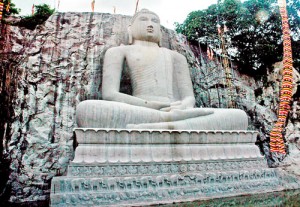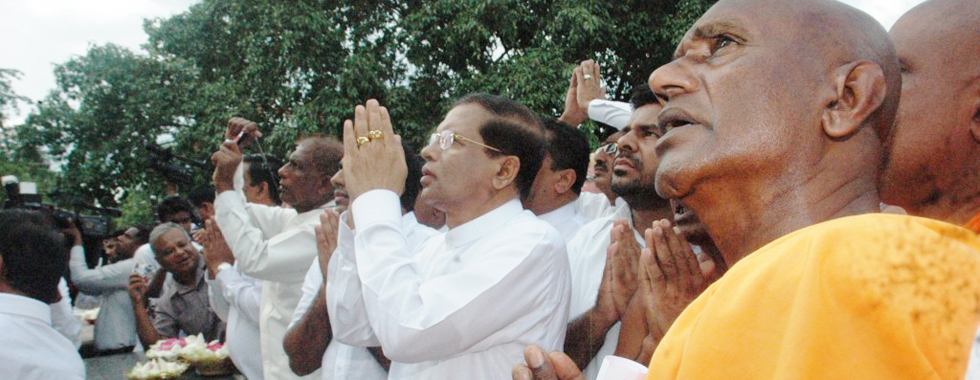A timely Vesak gift carved out of rock
It was March 2001. Ven. Egodamulle Amaramoli Thera recalled how a young boy rushed to his village temple, enraged about the destruction of the Bamiyan statues in Afghanistan and wanting to attack mosques in retaliation.

The towering Buddha statue
The monk talked to the boy. “We Buddhists don’t take revenge. We must be compassionate. Let’s see what we can do,” he told him and then had the idea of building a statue not second to the tallest one that had been destroyed.
Ven. Egodamulle Amaramoli Thera told me the story two years ago when I went to see the 67-feet tall statue being carved out of a huge granite rock in Kurunegala. It had reached the final stages then. Reckoned to be the largest seated Buddha statue in the world, work has just been completed after a little under 13 years. The statue officially unveiled on April 30, is bound to attract large crowds during the Vesak season.
The temple, Vidayasagara Piriven Vihara at Monaragala, Rambodagalla is situated off Kurunegala and can be reached by proceeding on the Kurunegala-Kandy road for about four kilometres, then turning left at the Mallawapitiya junction and continuing on the Keppetigala road for 20 km.
The monk soon realised it was going to be a massive task. Yet he made a firm resolution to construct a 50-foot tall seated Buddha rather than replicate the destroyed statues.
His mind flashed back to the Samadhi statue in Anuradhapura done in the 4th century CE and the rock-cut statues at Gal Vihara, Polonnaruwa,

President Maithripala Sirisena with Ven. Egodamulle Amaramoli Thera at the opening of the statue on Thursday. Pix by Pushpakumara Jayarathna
done centuries ago during the golden era of Sinhalese art and architecture. Who could do it today, he wondered.
The monk heard about a giant statue of Hanuman, the Hindu deity that had been built at Ramboda in the Nuwara Eliya district. Going there to see it, quite by chance he met a Hindu devotee who had financed the construction of the statue. He happened to be the well-known Colombo businessman, D. Easwaran of Easwaran Brothers. After a brief chat, he told the monk he would arrange a meeting with the sculptor from Chennai who had built the statue. The Indian sculptor was Muthu Muthiah Sthapathi– a world renowned artist who had been awarded the ‘Padma Sri’ by the Indian government.
When they met, the sculptor told the monk that he had never sculpted a statue of the Buddha earlier but was keen to take up the challenge. When he saw the rock that the monk had identified for the purpose, he was quite pleased. “I showed him pictures of the ‘Samadhi’ Buddha. At the site, he drew a small illustration on his palm and showed me. It was a tiny picture. The moment I saw it I realised he had grasped exactly what I had in mind,” Ven. Amaramoli Thera recalled.
He suggested to the monk that the statue should be over fifty feet tall if it was to make the desired impact. It should be taller, he said. Finally it was agreed to go up to 67.5 feet which really meant its standing height would be 108 feet.
A team of ten craftsmen – all Indian – started work on September 13, 2002. When I visited a pond was being built in front of the statue. “Once completed the appearance will be as if the Buddha is seated on a lotus emanating from the pond with its petals opened,” the monk said.
| A 2000 year-old tradition continues With the statue just completed, a tradition dating back to over 2000 years is being continued. Rock-cut Buddha images date back to the 5th century when the standing Buddha around 40 feet tall was carved on a huge rock at Avukana. Close to Avukana is another statue at Rasvehera. The tallest – over 50 feet – is at Buduruvagala at Wellawaya. It stands between images of ‘bodhisatvas’ Avalokiteshwara on the right and Manjusri on the left. These are smaller than the Buddha image.  Thirteen years in the making In a perfect state of preservation are four large rock-cut images at Gal-Vihara in Polonnaruwa – Sri Lanka’s second medieval capital from the 11th to the first quarter of the 13th century. They are in a row – two seated images, a standing image with folded arms and an enormous, recumbent image 46 feet 4 inches in length. The four images have been carved on a single, large granite rock face. This is considered among the best examples of rock carving and sculpture of the ancient Sinhalese. The four statues are on a rock face which has been cut back nearly 15 feet to accommodate them. One of the seated Buddha images is in the posture of meditation (‘dhyana mudra’) while the other depicts Buddha seated on a throne under a parasol of virtues (‘dharmachatra’). Of the `other two, one is a standing image 23 feet tall on a lotus petal and other a reclining Buddha. Seated and recumbent statues belonging to the latter part of the Anuradhapura Period can also be found at Tantirimale and Elahera. When Jawaharlal Nehru wrote in ‘The Discovery of India’ that “the Buddha statue at Anuradhapura in Ceylon moves me greatly and a picture of it has been my companion for many years”, he was referring to the image of the Buddha in Samadhi posture in Anuradhapura – regarded as the finest in Sri Lanka. However, the new statue is not a rock-cut statue but built out of dolomite. Rock-cut statues are rare – the one just completed is therefore unique in contemporary times. |


